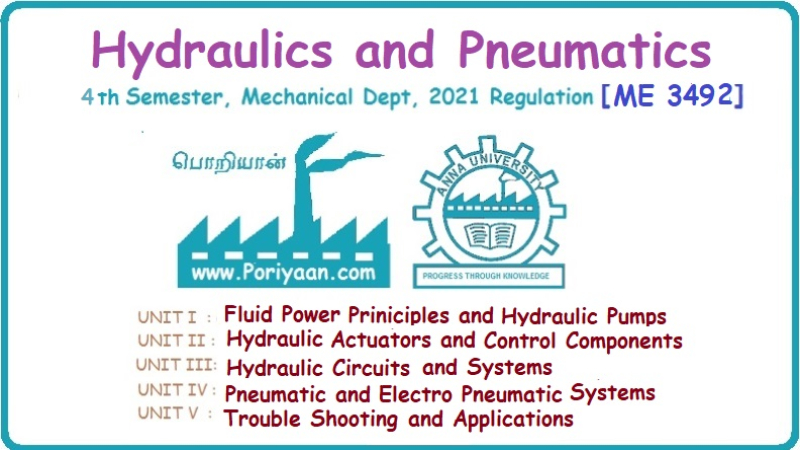Hydraulics and Pneumatics: Unit I: Fluid Power Priniciples and Hydraulic Pumps
methods of transmitting power
Fluid Power Priniciples and Hydraulic Pumps - Hydraulics and Pneumatics
The three basic methods of transmitting power are : 1. Electrical power transmission, 2. Mechanical power transmission, and 3. Fluid power transmission.
METHODS OF TRANSMITTING POWER • The three basic methods of transmitting power are : 1. Electrical power transmission, 2. Mechanical power transmission, and 3. Fluid power transmission. (a) Hydraulic power transmission, and (b) Pneumatic power transmission. • These three methods are explained in Table 1.2. However in practice combination of above methods are used to obtain the most efficient overall system. This text book is all about study of fluid power transmission system (i.e., hydraulics and pneumatics). Table 1.2. Methods of transmitting power • Concept: Electrical power is transmitted by imposing an electromagnetic field on a conductor. • Suitability: They are suitable for power transmission over long distances. • Disadvantages: The limitations of electric power transmission include magnetic saturation (which may limit the torque developed by an electric motor); material limitations (which may affect the speed); and heat dissipation problem. • Concept: Mechanical power is transmitted by employing a variety of kinematic mechanisms such as belts, chains, pulleys, sprockets, gear trains, bar linkages, and cams. • Suitability: They are suitable for the transmission of motion and force over relatively short distances. • Disadvantages: The disadvantages of mechanical power transmission include lubrication problems, limited speed and torque control capabilities, uneven force distribution, and relatively large space requirements. (a) Hydraulic Power Transmission: • Concept: Hydraulic power is transmitted by the pressure and flow of liquids. The most common liquids used are petroleum oils. • Suitability: They are suitable for power transmission over intermediate distances. That is, they can be employed over greater distances than mechanical types but not as far as electrical systems. • Advantages: Hydraulic systems are mechanically stiff, and can be designed to give fast operation and move very heavy loads. • Disadvantages: The disadvantages of hydraulic system include hydraulic fluid leakage; impairment of system operation by contamination; and fire hazards with flammable hydraulic fluids. (b) Pneumatic Power Transmission: • Concept: Pneumatic power transmitted by the pressure and flow of compressed gases. The most commonly used gas is air. • Suitability: They are suitable for power transmission over intermediate distances. • Advantages: Pneumatic systems use simple equipment, have small transmission lines, and do not present a fire hazard. • Disadvantages: The disadvantages of pneumatic system include a high fluid compressibility and a small power-to-size ratio of components.1. Electrical Power Transmission:
2. Mechanical Power Transmission:
3. Fluid Power Transmission:
Hydraulics and Pneumatics: Unit I: Fluid Power Priniciples and Hydraulic Pumps : Tag: : Fluid Power Priniciples and Hydraulic Pumps - Hydraulics and Pneumatics - methods of transmitting power
Related Topics
Related Subjects
Hydraulics and Pneumatics
ME3492 4th semester Mechanical Dept | 2021 Regulation | 4th Semester Mechanical Dept 2021 Regulation
